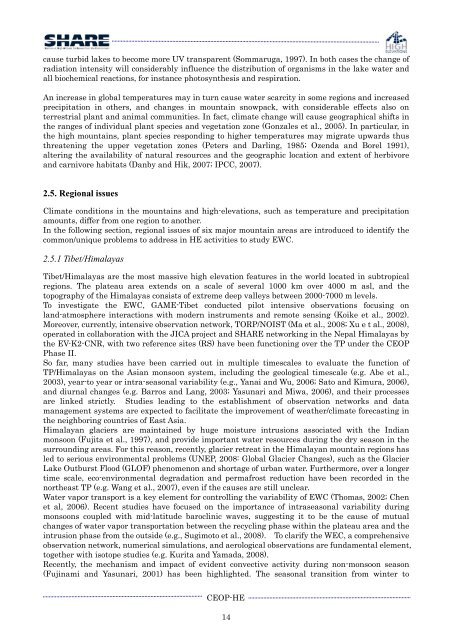here - CEOP-HE
here - CEOP-HE
here - CEOP-HE
Create successful ePaper yourself
Turn your PDF publications into a flip-book with our unique Google optimized e-Paper software.
cause turbid lakes to become more UV transparent (Sommaruga, 1997). In both cases the change of<br />
radiation intensity will considerably influence the distribution of organisms in the lake water and<br />
all biochemical reactions, for instance photosynthesis and respiration.<br />
An increase in global temperatures may in turn cause water scarcity in some regions and increased<br />
precipitation in others, and changes in mountain snowpack, with considerable effects also on<br />
terrestrial plant and animal communities. In fact, climate change will cause geographical shifts in<br />
the ranges of individual plant species and vegetation zone (Gonzales et al., 2005). In particular, in<br />
the high mountains, plant species responding to higher temperatures may migrate upwards thus<br />
threatening the upper vegetation zones (Peters and Darling, 1985; Ozenda and Borel 1991),<br />
altering the availability of natural resources and the geographic location and extent of herbivore<br />
and carnivore habitats (Danby and Hik, 2007; IPCC, 2007).<br />
2.5. Regional issues<br />
Climate conditions in the mountains and high-elevations, such as temperature and precipitation<br />
amounts, differ from one region to another.<br />
In the following section, regional issues of six major mountain areas are introduced to identify the<br />
common/unique problems to address in <strong>HE</strong> activities to study EWC.<br />
2.5.1 Tibet/Himalayas<br />
Tibet/Himalayas are the most massive high elevation features in the world located in subtropical<br />
regions. The plateau area extends on a scale of several 1000 km over 4000 m asl, and the<br />
topography of the Himalayas consists of extreme deep valleys between 2000-7000 m levels.<br />
To investigate the EWC, GAME-Tibet conducted pilot intensive observations focusing on<br />
land-atmosp<strong>here</strong> interactions with modern instruments and remote sensing (Koike et al., 2002).<br />
Moreover, currently, intensive observation network, TORP/NOIST (Ma et al., 2008; Xu e t al., 2008),<br />
operated in collaboration with the JICA project and SHARE networking in the Nepal Himalayas by<br />
the EV-K2-CNR, with two reference sites (RS) have been functioning over the TP under the <strong>CEOP</strong><br />
Phase II.<br />
So far, many studies have been carried out in multiple timescales to evaluate the function of<br />
TP/Himalayas on the Asian monsoon system, including the geological timescale (e.g. Abe et al.,<br />
2003), year-to year or intra-seasonal variability (e.g., Yanai and Wu, 2006; Sato and Kimura, 2006),<br />
and diurnal changes (e.g. Barros and Lang, 2003; Yasunari and Miwa, 2006), and their processes<br />
are linked strictly. Studies leading to the establishment of observation networks and data<br />
management systems are expected to facilitate the improvement of weather/climate forecasting in<br />
the neighboring countries of East Asia.<br />
Himalayan glaciers are maintained by huge moisture intrusions associated with the Indian<br />
monsoon (Fujita et al., 1997), and provide important water resources during the dry season in the<br />
surrounding areas. For this reason, recently, glacier retreat in the Himalayan mountain regions has<br />
led to serious environmental problems (UNEP, 2008: Global Glacier Changes), such as the Glacier<br />
Lake Outburst Flood (GLOF) phenomenon and shortage of urban water. Furthermore, over a longer<br />
time scale, eco-environmental degradation and permafrost reduction have been recorded in the<br />
northeast TP (e.g. Wang et al., 2007), even if the causes are still unclear.<br />
Water vapor transport is a key element for controlling the variability of EWC (Thomas, 2002; Chen<br />
et al, 2006). Recent studies have focused on the importance of intraseasonal variability during<br />
monsoons coupled with mid-latitude baroclinic waves, suggesting it to be the cause of mutual<br />
changes of water vapor transportation between the recycling phase within the plateau area and the<br />
intrusion phase from the outside (e.g., Sugimoto et al., 2008). To clarify the WEC, a comprehensive<br />
observation network, numerical simulations, and aerological observations are fundamental element,<br />
together with isotope studies (e.g. Kurita and Yamada, 2008).<br />
Recently, the mechanism and impact of evident convective activity during non-monsoon season<br />
(Fujinami and Yasunari, 2001) has been highlighted. The seasonal transition from winter to<br />
<strong>CEOP</strong>-<strong>HE</strong><br />
14


